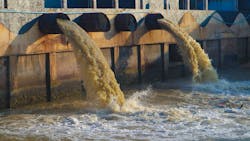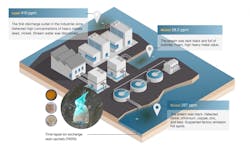Heavy metal pollution in wastewater from industrial activities is a significant environmental issue. Discharging untreated wastewater that contains heavy metals into the environment can contaminate aquatic life and agricultural crops. Heavy metals can then enter the food chain, be absorbed through the human body and potentially cause serious health issues due to their toxicity.
Sources of industrial wastewater containing heavy metals include:
- Electric power plants
- Metal surface treatment
- Electroplating
- Electronics manufacturing
- Organic chemicals manufacturing
- Iron and steel industry
- Mines and quarries
Finding a rapid method to detect heavy metals pollution in wastewater
The ability to quickly detect heavy metal pollution in wastewater and locate its source are critical for environmental monitoring and protection. To locate and address point source pollution, monitoring agencies need a robust, versatile and rapid analytical method to identify and detect the presence of heavy metal contaminants in wastewater. Modern analytical instruments such as portable X-ray fluorescence (pXRF) analyzers can empower agencies to detect, locate and address sources of wastewater contamination swiftly and accurately.
For example, the Vanta handheld XRF analyzer is a versatile environmental monitoring solution with the following capabilities:
- Accurate elemental analysis: Analyzes more than 20 elements, including the heavy metals chromium (Cr), nickel (Ni), copper (Cu), zinc (Zn), arsenic (As), cadium (Cd), mercury (Hg) and lead (Pb).
- Fast results: Provides immediate qualitative and quantitative information in real time.
- Field ready: Lightweight, portable and rugged for fieldwork conditions.
- Nondestructive: Chemical analysis method that does not damage the sample.
- Productive: User-friendly interface makes the device easy to use with minimal training.
- Economical: Affordable and low cost of ownership.
Despite these benefits, pXRF analyzers face some challenges for heavy metal testing in wastewater. First, these devices are typically calibrated for use on solid materials such as soil. Second, the limit of detection (LOD) is only in the single-digit parts per million (ppm) range. More expensive and time-consuming laboratory methods, such as atomic absorption spectrometry (AAS) or inductively coupled plasma (ICP), can measure parts per billion (ppb) levels.
The solution: Combining time-lapse ion exchange resin sachets and portable XRF
To overcome these challenges, time-lapse ion exchange resin sachets (TIERS) can be combined with pXRF testing to optimize the analysis of heavy metals in wastewater. A time-lapse ion exchange resin sachet is a non-woven bag that contains resins that adsorb metals over time. The bag is placed in a body of water (e.g., the water surrounding discharge pipeline outlets at a processing facility) for seven days as the resins accumulate heavy metals. After the seven-day monitoring period, the TIERS is tested using a pXRF analyzer.
Time-lapse ion exchange resin sachets help optimize XRF analysis of wastewater in several ways:
- Lower limits of detection: Amplifies analytes up to 1,000 times; the concentration factor increases sensitivity and reduces matrix effects.
- Higher precision: Sachets effectively provide a time average over the seven-day deployment to account for variable discharge concentration and volume.
- Real-time field mapping: Customizable qualitative and quantitative data tagged to each area is analyzed for easier, more comprehensive interpretation of results.
The importance of portable XRF in environmental monitoring
A fast, reliable and inexpensive field-based monitoring system enables regulators to work their way upstream to locate problematic discharges. TIERS consistently monitor a location for an entire week to identify even intermittent problems. As industries continue to expand water use rapidly, nearby water user groups are increasingly looking for confidence that regulations are being met. Cases of non-compliance are increasingly difficult to identify without real-time monitoring. Modern analytical solutions such as portable XRF can help streamline and expedite extensive testing processes, helping agencies save resources and promptly resolve environmental health hazards.
Vincent Lee graduated from University of Western Australia with Degree in Bachelor of Science (Chemistry). He started his career in Bureau Veritas Consumer Products Services as an Inorganic Engineer, specializing in ICP-OES, ICP-MS, HD-XRF, AAS and UV-Vis Spectroscopy. In 2015, Vincent joined the Olympus team as a product manager. He has more than five years of experiences in developing the regional business with Olympus team. He is also responsible for regional application support covering distributor training, solving and developing new applications.



